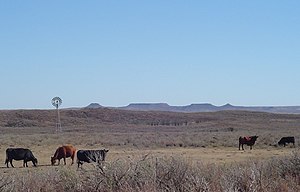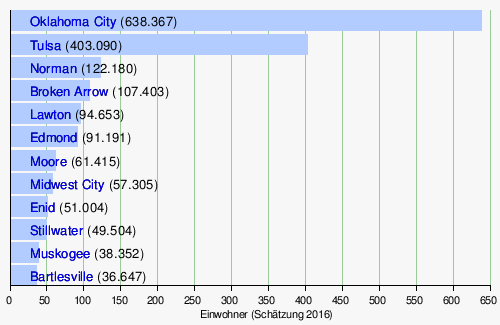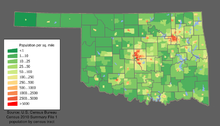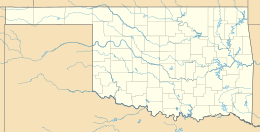Oklahoma
![]()
The title of this article is ambiguous. For other meanings, see Oklahoma (disambiguation).
Oklahoma (English pronunciation [![]()
![]() ˌoʊkləˈhoʊmə]) is a state in the south-central United States, north of Texas. The word Oklahoma comes from the Choctaw language: okla 'the man' and humma 'red', the compound meaning "The land of the red man". Oklahoma's epithet is The Sooner State. The background of this epithet was the pioneers who settled the land purchased from the Indians by the U.S. government before (sooner) the legal initial settlement period. The capital of Oklahoma is Oklahoma City.
ˌoʊkləˈhoʊmə]) is a state in the south-central United States, north of Texas. The word Oklahoma comes from the Choctaw language: okla 'the man' and humma 'red', the compound meaning "The land of the red man". Oklahoma's epithet is The Sooner State. The background of this epithet was the pioneers who settled the land purchased from the Indians by the U.S. government before (sooner) the legal initial settlement period. The capital of Oklahoma is Oklahoma City.
Geography
Location and extent
Oklahoma has six neighboring states: Arkansas and Missouri to the east, Kansas to the north, and Colorado to the northwest. To the far west Oklahoma borders New Mexico and to the south Texas.
Oklahoma has an area of 181,035 km² (20th rank of the US states).
Regions
Oklahoma lies largely within the Great Plains region. The Central Lowlands are occupied by the Osage Plains, a gently rolling plain interrupted only in a few places by hill country. The lowland region changes to highlands to the east. To the northeast are foothills of the Ozark Plateau. Rivers have carved deep canyons into this limestone massif. South of this plateau are the sandstone Ouachita Mountains. To the extreme southeast, the state shares the Gulf Coastal Plain. To the west the Central Lowlands merge into the Great Plains. Northeastern Oklahoma is crossed by the Arkansas Valley, which includes the Arkansas River valley and surrounding plains. This area is very fertile and is considered one of the most important agricultural regions of the state.
Waters
Oklahoma's waters drain mainly in an easterly direction via the Red River and the Arkansas River. The southern part of the state belongs to the catchment area of the former river. Through it the water enters the Atchafalaya River, from which it flows into the Gulf of Mexico. The most important tributary of the Red River is the Washita River. Northern Oklahoma is part of the Arkansas River basin. This flows into the Mississippi River, so that this part of the water is also drained via the Gulf of Mexico. The most important tributaries of the Arkansas are the Cimarron, the Canadian, the North Canadian and the Neosho.
The majority of lakes are man-made reservoirs, of which there are about 200. They were built for flood control, water supply, power generation and recreational purposes. Lake Texoma is the only reservoir on the Red River and, with a volume of more than 3 km³, is the largest lake in this respect. In contrast, Eufaula Lake has the largest surface area at 400 km². Natural stillwaters are limited to a few oxbow lakes. In addition, lakes without drainage occur in the semi-arid region of the High Plains and dry up during periods of low rainfall.
Climate
With regard to climatic conditions in Oklahoma, it can be observed that the average rainfall - due to easterly winds that transport moist air from the tropics towards the mainland but are less dominant in the west - decreases from east to west and temperatures from south to north. Thus, the climate in the south is subtropical with mild winters and hot and humid summers (effective climate classification: Cfa). Average temperatures in the warmest area range from 7 °C in January to 29 °C in July. Towards the north, the transition to the continental climate of the Great Plains (Dfa) is slowly noticeable: summers are almost as warm as in the southern part of the state, but winters are considerably colder with sometimes severe night frosts. Temperatures vary throughout the year from 0 °C in January to 27 °C in July. The northwest (Oklahoma Panhandle) has a semi-arid steppe climate (BSk). Here, temperatures range from 0 °C in January to 25 °C in July.
Record temperatures are -35 °C (2011) and 49 °C (1936, 1943). Summers are generally hot and of long duration. Temperatures often rise to 35 to 40 °C (95 to 104 °F) during the summer months. In contrast, years in which the 100 °F (circa 38 °C) mark is not exceeded are very rare. Winters are significantly shorter. Frost occurs on an average of 60 days a year in the southeast and 140 days in the northwest.
Oklahoma is repeatedly hit by various natural disasters. For example, large parts of the state belong to Tornado Alley. Tornadoes occur when hot air from the south meets cold air from the Rocky Mountains to the north. This occurs most frequently in the spring during the months of March through June. A series of tornadoes in May 1999 caused particularly severe devastation. The top speed of the most violent tornado near Oklahoma City was 517 kilometres per hour. Droughts and earthquakes also cause problems.
|
| |||
| The three climate zones of Oklahoma |
| Average temperatures and precipitation in Oklahoma in °C and mm, respectively (1981-2010). | ||||||||||||
| City | Jan | Feb | Mar | Apr | May | Jun | Jul | Aug | Sep | Oct | Nov | Dec |
| Guymon | -7/9 | -6/11 | -2/17 | 3/21 | 9/27 | 15/31 | 18/34 | 17/33 | 12/29 | 5/23 | -2/16 | -6/11 |
| 8 | 12 | 22 | 29 | 45 | 80 | 55 | 69 | 42 | 39 | 20 | 17 | |
| Located in the northwest, Guymon has a semi-arid climate with moderate rainfall, most of which falls in the summer months. In winter it is dry and cold, while in summer it can be hot. At night it cools down by up to 20 °C. | ||||||||||||
| Durant | -1/12 | 1/14 | 5/19 | 9/23 | 15/27 | 20/31 | 22/34 | 21/35 | 16/30 | 10/25 | 5/18 | -1/13 |
| 58 | 72 | 103 | 102 | 132 | 140 | 81 | 61 | 96 | 118 | 91 | 81 | |
| Located in the far south, Durant has a subtropical climate with large amounts of rainfall year-round. Winters are relatively mild and short-lived, while summers are very hot and last for months. | ||||||||||||
| Oklahoma City | -2/10 | 0/13 | 5/17 | 10/22 | 15/27 | 20/31 | 22/34 | 22/34 | 17/29 | 11/23 | 4/16 | -1/10 |
| 35 | 40 | 78 | 78 | 118 | 125 | 74 | 83 | 103 | 94 | 50 | 48 | |
| The centrally located capital Oklahoma City also officially has a subtropical climate. However, the winters are somewhat cooler than in Durant to the south. Precipitation falls year-round with a focus in the spring months. | ||||||||||||
| Newkirk | -6/7 | -4/10 | 1/15 | 6/20 | 13/25 | 18/30 | 20/33 | 20/33 | 15/28 | 8/22 | 1/15 | -5/7 |
| 25 | 42 | 77 | 102 | 132 | 146 | 99 | 87 | 93 | 97 | 55 | 42 | |
| Newkirk, located in far northern Oklahoma, has a full-humid continental climate. Winters are cold and summers are hot. High rainfall is expected, especially during the summer months. | ||||||||||||
flora and fauna
Natural Landscapes of Oklahoma
The flora of Oklahoma includes an estimated 2500 species. Analogous to the climatic conditions, a transition from east to west can also be observed here. The humid east is dominated by woodlands of oaks, hickories, and pines. Examples of this landscape are the Ouachita Mountains as well as the Ozark Plateau. The center of the state provides a transition to the prairie landscape of the High Plains. In addition to the typical prairie grasses, shrubs and smaller trees occur. Westward, both the length of grasses and the overall diversity of vegetation decrease. In the Panhandle, short buffelgrass is the most common plant, while trees grow only near water due to dry conditions.
Oklahoma's fauna has been greatly altered by man. The bison, wapiti, and antelope have been largely eradicated and now live only in wildlife refuges. Completely disappeared are the black-footed tilapia, the red wolf, the wolf and the brown bear. Instead, the house mouse, the Norway rat, the house rat and the nutria reached the New World and finally Oklahoma through human influence.
The different vegetation in the state has an influence on the wildlife. For deer, otter, raccoon, mink, and gray squirrel, the transition from woodland to prairie landscape marks the western boundary of their range. Western Oklahoma is home to animals typical of the Great Plains and Rocky Mountains, including rabbit, gopher, prairie dog, and coyote. Bird life is exceedingly diverse. The most common bird species are meadow blackbird, mockingbird, migratory thrush, blue jay, crow, and sparrow. Wild ducks are common on the Great Salt Flats in the northern part of the state.

The Washita River is a tributary of the Red River.

Tornadoes regularly cause serious damage.

Large forested areas such as in the Ouachita Mountains are typical of the eastern part of the state.

Further west, the barren prairie landscape of the High Plains predominates. Here is a scene in Roger Mills County
Population
| Population development | |||
| Census | Inhabitants | ± in % | |
| 1890 | 258.657 | - — | |
| 1900 | 790.391 | 205,6 % | |
| 1910 | 1.657.155 | 109,7 % | |
| 1920 | 2.028.283 | 22,4 % | |
| 1930 | 2.396.040 | 18,1 % | |
| 1940 | 2.336.434 | −2,5 % | |
| 1950 | 2.233.351 | −4,4 % | |
| 1960 | 2.328.284 | 4,3 % | |
| 1970 | 2.559.229 | 9,9 % | |
| 1980 | 3.025.290 | 18,2 % | |
| 1990 | 3.145.585 | 4 % | |
| 2000 | 3.450.654 | 9,7 % | |
| 2010 | 3.751.351 | 8,7 % | |
| Estimate 2014 | 3.878.051 | 3,4 % | |
| Before 1900 1900–1990 2000 2014 | |||
Oklahoma has about 3.9 million inhabitants according to the official estimate from 2014. The population density is 21 inhabitants per square kilometer. Most of the population is concentrated in the eastern part of the state.
Population distribution
With an absolute figure of 2.5 million people, about two-thirds of Oklahoma's residents live in urbanized areas, i.e., places with a population of at least 2,500 people. In 2010, the United StatesCensus Bureau counted five areas with a particularly high population concentration (urbanized areas) that have grown up around the cities of Oklahoma City, Tulsa, Norman, Lawton and Fort Smith, which is located in the neighboring state of Arkansas near the Oklahoma border. The remaining 1.3 million people (about 34%) inhabit rural areas that make up 98% of the state.
Religions
The main religious communities in 2000:
967,233 Southern Baptist Convention, 322,794 United Methodist Church, 168,625 Catholic Church
There are many other denominations, especially Protestant denominations.
Population composition
According to the official 2013 estimates, whites make up 75.4 percent of the total population. Native American ethnic groups are far more prevalent than in most other states at 9.0 percent. The largest Native American groups are Cherokee, Chickasaw, Choctaw, Muskogee, and Seminole. Asian ethnic groups (including Vietnamese, Chinese, and Koreans) also live in Oklahoma.
The percentage of Oklahoma's African-American community in 2013 was 7.7 percent, well below the national average. African Americans arrived in what is now Oklahoma as early as the 19th century via the Trail of Tears, where they were held as slaves by Native American tribes. After slavery was outlawed in 1865, many African Americans moved to so-called All-Black Towns, which still exist in small numbers today.
Education
Major universities in Oklahoma include Oklahoma State University - Stillwater and the University of Oklahoma.
Largest cities

See also: List of places in Oklahoma

Population density (2010)

Age pyramid of Oklahoma (as of 2000)
Questions and Answers
Q: What is the population of Oklahoma?
A: The population of Oklahoma in 2010 was about 3,751,351 people.
Q: How large is the land area of Oklahoma?
A: The land area of Oklahoma is about 68,667 sq mi (177,847 km2).
Q: What does the name "Oklahoma" mean?
A: The name "Oklahoma" comes from the Choctaw words okla and humma which means "Red People".
Q: When did Oklahoma become a state?
A: Oklahoma became a state on November 16th, 1907. It was the 46th state to become part of the United States.
Q: What are some major industries in Oklahoma?
A: Major industries in Oklahoma include aviation, energy, telecommunications, and biotechnology.
Q: How many Native American languages are spoken in Oklahoma?
A: More than 25 Native American languages are spoken in Oklahoma, more than any other state.
Q: What religion do most Oklahomans believe in?
A: Most Oklahomans believe in evangelical Christianity and it is part of the Bible Belt.
Search within the encyclopedia
